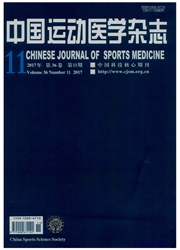

 中文摘要:
中文摘要:
目的:观察一次性力竭运动过程中大鼠纹状体内神经递质谷氨酸(Glu)和γ-氨基丁酸(GABA)含量及其比值的动态变化,探讨运动疲劳后纹状体神经元电活动改变的可能机制。方法:8周龄雄性Wistar大鼠8只,通过手术预先将透析套管定植入左侧纹状体(P:0.2,L:3,H:3.2)。采用活体微透析与高效液相色谱(HPLC)检测联用技术,动态观察一次性力竭运动过程中及恢复期纹状体内神经递质Glu和GABA含量及其比值的变化规律。结果:Glu含量及Glu/GABA比值从运动即刻开始上升,力竭期前60 min达到最高水平,随后开始回降,并在恢复期30min降到最低点,之后又开始回升;GABA水平在运动开始后缓慢下降,力竭期前30 min达到最低点,之后上升并在力竭期后又回降。结论:运动疲劳时纹状体内Glu和GABA浓度变化是导致神经元兴奋性改变以及大鼠运动能力降低的重要原因之一。
 英文摘要:
英文摘要:
Purpose To investigate the dynamic changes in levels of glutamate(Glu)acid and γ-aminobutyric acid(GABA)in rat striatum in vivo during exhaustive exercise and 90 minutes after exhaustion.Methods Eight male Wistar rats(8 weeks old)were used in the experiment.A cannula with replaceable inner guide was inserted into the left striatum(P: 0.2,L: 3,H: 3.2).Microdialysis and high pressure liquid chromatography techniques were used to detect the changes of the Glu and GABA in vivo during the exhaustive exercise and 90 minutes after exhaustion.The Glu/GABA ratio in rat striatum was also calculated.Results The level of Glu and Glu/GABA ratio rose at the beginning of the exercise,and reached their peak 60 minutes after exercise.The level of GABA began to drop after the beginning of the exercise,and reached the minimum 30 minutes before exhaustion.Conclusion The changes in Glu and GABA concentrations in rat striatum during exhaustive exercise is one of the most important reasons for altering neurons activity and thus impair the exercise performance.
 同期刊论文项目
同期刊论文项目
 同项目期刊论文
同项目期刊论文
 Increased extracellular dopamine and 5-hydroxytryptamine levels contribute to enhanced subthalamic n
Increased extracellular dopamine and 5-hydroxytryptamine levels contribute to enhanced subthalamic n Applying H-1 NMR Spectroscopy to Detect Changes in the Urinary Metabolite Levels of Chinese Half-Pip
Applying H-1 NMR Spectroscopy to Detect Changes in the Urinary Metabolite Levels of Chinese Half-Pip 期刊信息
期刊信息
